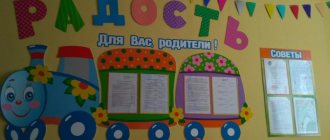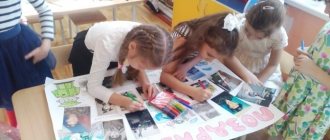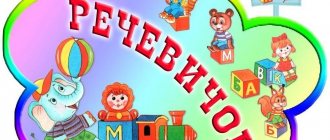How to correctly develop a summary of direct educational activities according to the Federal State Educational Standard
Dear colleagues, I offer an approximate example of a summary of direct educational activities. This does not mean that the entire country should write this way. Each region may have its own note-writing traditions . The most important thing is that the notes must reflect current trends in the development of preschoolers and be methodologically correct.
First of all, it should be noted that there is currently no clear replacement for the word “occupation”. In some regions it is called “direct educational activity” (DEA), in others – “organized educational activity” (OOA), in still others – “educational situation” (OS). All these definitions are correct, as they reflect specific educational activities. But in defense of the word “occupation,” I want to say that preschool teachers have always put a slightly different meaning into this concept than, for example, school teachers. Our lesson was held in a playful way, with various problematic situations, surprise moments and good physical activity of the pupils. There has never been a purely educational activity in kindergarten!
So, summary: 1. Title. It is not necessary to write the name of the educational activity in the title (for example, a summary of the educational activity “Visiting Parsley”). You can simply indicate the direction of activity (“Summary of direct educational activities on cognitive development”). Write the age (group) of the children (for children of senior preschool age).
2. After the title, you can indicate the priority educational area in the GCD process and, preferably, integration with other educational areas , as well as the integration of children's activities.
3. The forms of organizing collective activities are indicated (work in subgroups, in pairs, joint activities of the teacher with children) and independent activities of children (if planned).
4. Further indicate: material and equipment; preliminary work; planned results.
5. Tasks. I would like to immediately warn teachers against making mistakes. Some colleagues write: “ GCD goals This is methodologically incorrect. The goal is the final and overall result, extended over time. What goal can be achieved, for example, in 15 minutes of educational activity in a younger group? It is more correct to write the word “goal”, for example, when developing planning for a complex (i.e., several) GCD, when developing a project (since it is multifaceted) and other time-extensive complexes of educational activities . Moreover, there is only one goal, but there can be many tasks. And for a specific educational activity, specific tasks are suitable that must be solved by the end of this educational activity (after 15 minutes in the junior group or after 35 minutes in the preparatory group). That is, if a teacher wrote a problem in the GCD notes, then he must solve it in the GCD process . Therefore, do not write 10-15 problems in your notes. Five, maximum six is enough. You can replace the word “tasks” with the phrase “program content”. Do not write the verb “teach” ! It is more correct to write “to promote”, “to form skills”, “to create conditions”, “to develop”, “to involve”, etc. Tasks can be divided into 3 groups: developmental, educational, educational (educational). I would like to draw your attention to an interesting nuance: many teachers write the word “educational” instead of the word “educational”, meaning only educational tasks. But the concept of “education” (read the law “On Education in the Russian Federation”) includes both training and upbringing . This means that educational tasks will involve both teaching and educational tasks together . In this case, you will have 2 groups of tasks: developmental and educational .
6. The progress of direct educational activities. I reflected the main points of the educational activity itself in the article “How to develop a developmental lesson ,” since any educational activity according to the Federal State Educational Standard should be developmental.
Introductory part (motivational stage). The teacher must motivate children to engage in cognitive (or play) activities using a problem or play situation. This situation is described in the outline.
The main part (content, activity stage). The outline describes educational situations, problem situations, game situations, communication situations, speech exercises, didactic games, etc. In the process of these situations and games, children are given new knowledge, those already acquired are consolidated, and problematic issues are resolved.
The final part (reflective stage). In the notes, write down the teacher’s questions, with the help of which he captures new concepts and new knowledge from the students, and also helps the children analyze their own and collective activities in the process of educational activities.
Dear teachers! If you have questions about the topic of the article or have difficulties in working in this area, then write in the comments. I'll definitely help. Golovina Bela Gennadievna, site administrator.
https://detstvogid.ru/kak-pravilno-sostavit-konspekt-neposredstvenno-obrazovatelnoy-deyatelnosti-po-fgos/.html
SUMMARY OF METHODOLOGICAL DEVELOPMENT OF GND
METHODOLOGICAL RECOMMENDATIONS FOR REGISTRATION OF METHODOLOGICAL DEVELOPMENT
1- 3 SLIDE
— Good afternoon, dear colleagues! Today we have gathered to find out what methodological development is and its types.
Learn to plan educational activities correctly, competently and thoughtfully.
4 SLIDE
What is methodological development
- this is a manual that reveals the forms, means, methods of teaching, elements of modern pedagogical technologies or the technologies of training and education themselves in relation to a specific topic of the lesson, the topic of the main or additional educational program.
Methodological development is aimed at professional and pedagogical improvement of the teacher or the quality of children’s preparation. It can be both individual and collective.
5 SLIDE
Methodological development can be:
development of a specific lesson or educational activity;
developing a series of lessons;
development of an educational program:
development of original teaching methods and preschool educational programs;
development of cultural and leisure activities;
development of new forms, methods or means of training and education;
GUIDELINES
FOR
METHODOLOGICAL DEVELOPMENT OF GND
6 SLIDE
In connection with the introduction of the Federal State Educational Standard for Preschool Education, many changes have occurred in the organization of educational work in preschool educational institutions.
One of these changes is the organization of direct educational activities.
A lot of time has passed since the release of the first document, but some teachers still have questions when preparing notes, organizing and conducting GCD. This is due to the fact that the previous model of conducting classes existed for a long time, and we got used to it.
Many teachers try to transform the lesson and turn it into a GCD, take the lesson notes “the old fashioned way”, first include some problematic situation, productive activity and - done!
But the essence has not changed!
This happens because teachers do not quite understand the essence of the joint activity of a teacher with children, they do not see how educational activity directly differs from a lesson.
To properly organize GCD, you need to have a good understanding of some issues and identify the difference between “occupation” and “GCD”...
Distinctive features of directly organized activities primarily in –
Ø forms of its organization,
Ø in changing the position of the teacher in relation to children,
Ø in updating the structure of the GCD.
What does the Federal State Educational Standard offer us?
The educational block is excluded from the educational process, but the learning process is not excluded, that is, the form of classes changes. In the joint activities of children and adults, a new form appears - directly educational activity filled with new content.
7 SLIDE
This leads to the main tasks of a preschool teacher when conducting educational activities:
ü to achieve maximum activity of children,
ü include all students in the creative process,
ü to form a stable interest in the subject being studied,
ü encourage you to gain knowledge and acquire specific skills.
Making educational activities bright and interesting is possible only with careful preparation and planning.
To do this you need:
8SLIDE
ü Define the goal, select and clearly formulate educational, developmental, educational tasks in accordance with age and level of development. Determine the dosage and combination of different tasks.
When setting, there should be no dominance of learning tasks.
We take into account targets at the stages of completion of early and preschool age.
9 SLIDE
ü Think over the structure of the GCD, the appropriateness of time allocation, the rationality of organizing the work of the teacher and students.
The presence of a logic of transition from one structural part to another, their approximate duration.
ü Consider the beginning of educational activities, creating motivation in children, the course of educational activities and the end.
ü The content of the GCD must correspond to the implemented program (educational system), take into account the level of development of students, their age characteristics.
10 SLIDE
ü Select games and exercises to implement the assigned tasks. There must be a sufficient number of games, exercises, tasks, their variety, compatibility with each other, and effectiveness in achieving the assigned tasks.
ü Determine didactic tools: their placement, sequence of use.
11- 17 SLIDES
ü Choose a form of organization of OD (game, exercise, primary educational, in-depth cognitive, generalizing, complex);
Please note, colleagues, on the screen possible forms for organizing children's activities are provided. (Transfer)
18 SLIDE
ü Formulate tasks and questions for children, possible remarks, explanations, instructions. The teacher is required to be precise, precise, clear, and concise in the formulation of tasks, when explaining games, exercises, in instructions on what and how to do for children, in describing problem and game situations.
19 SLIDE
ü Important
take into account maintaining a balance between entertaining elements and educational content.
20 SLIDE
ü Maintaining a balance between the word and action of the teacher and children in the text of the summary. A teacher should not dominate children! It is important to identify and support children’s initiative, to create conditions for the manifestation of their activity and independence.
21 SLIDES
ü In the final part - summing up. Clarify what new things have been learned and where they can be applied. For children of senior preschool age, the primary formation of reflection skills is possible. To do this, it is important to think through questions that will push children to realize
own actions, emotions...





